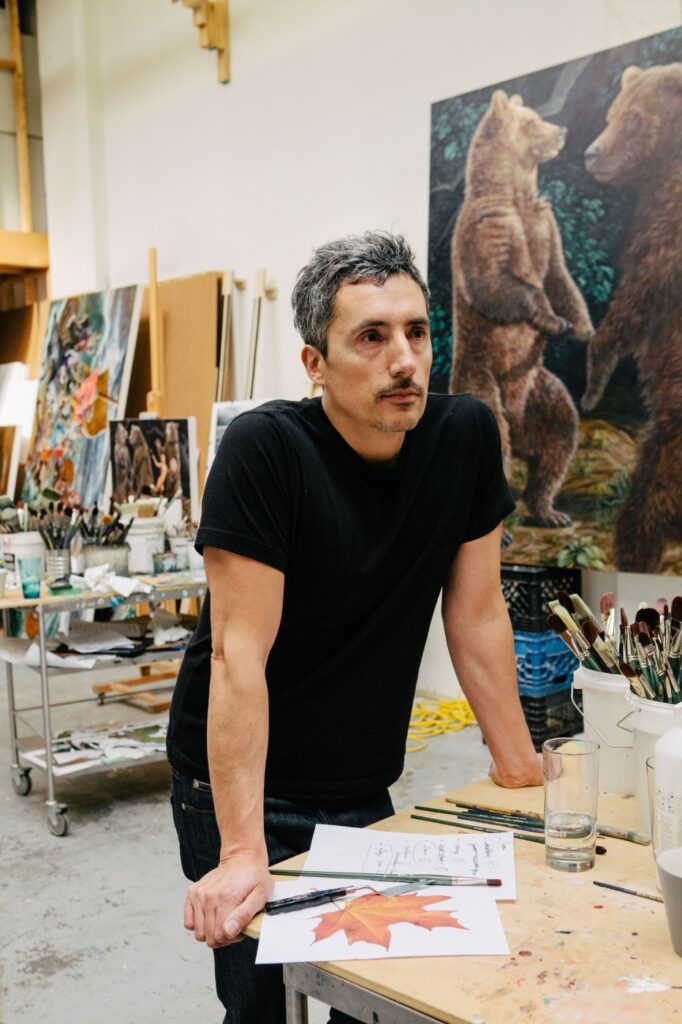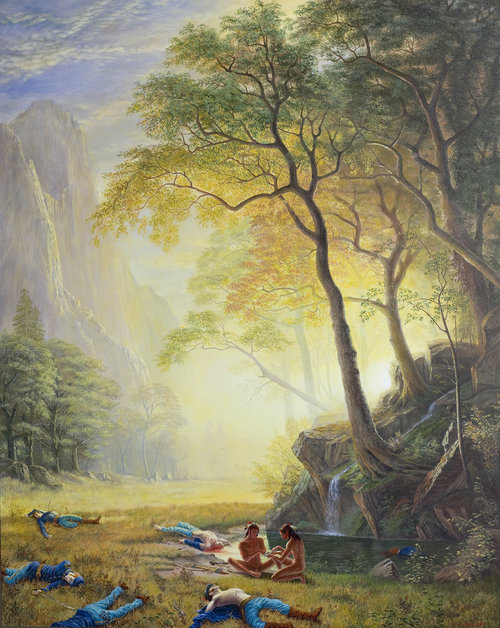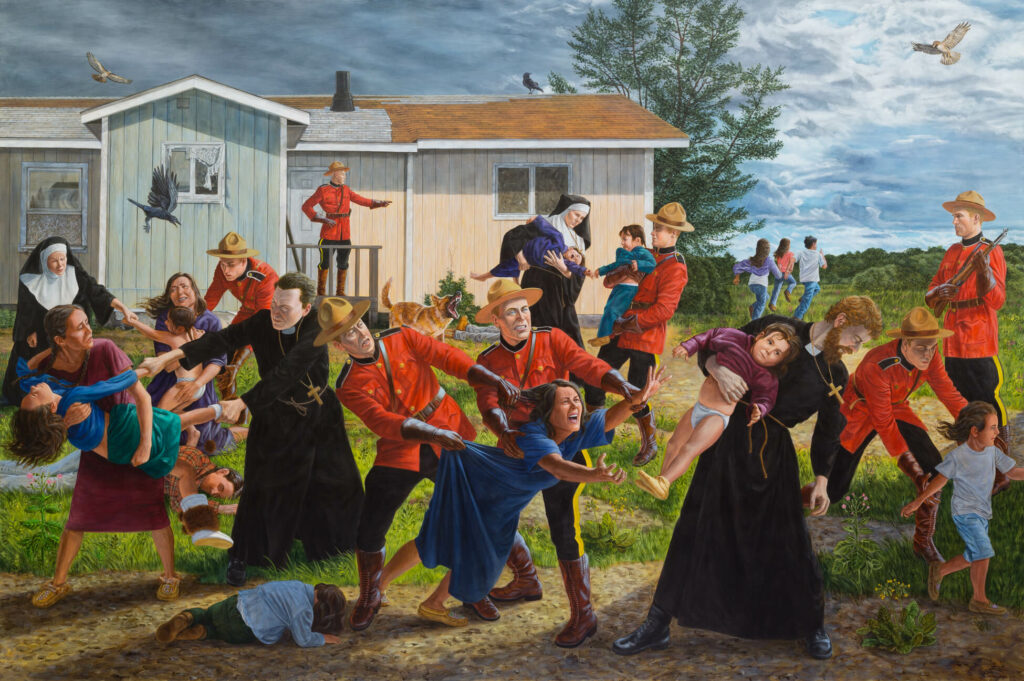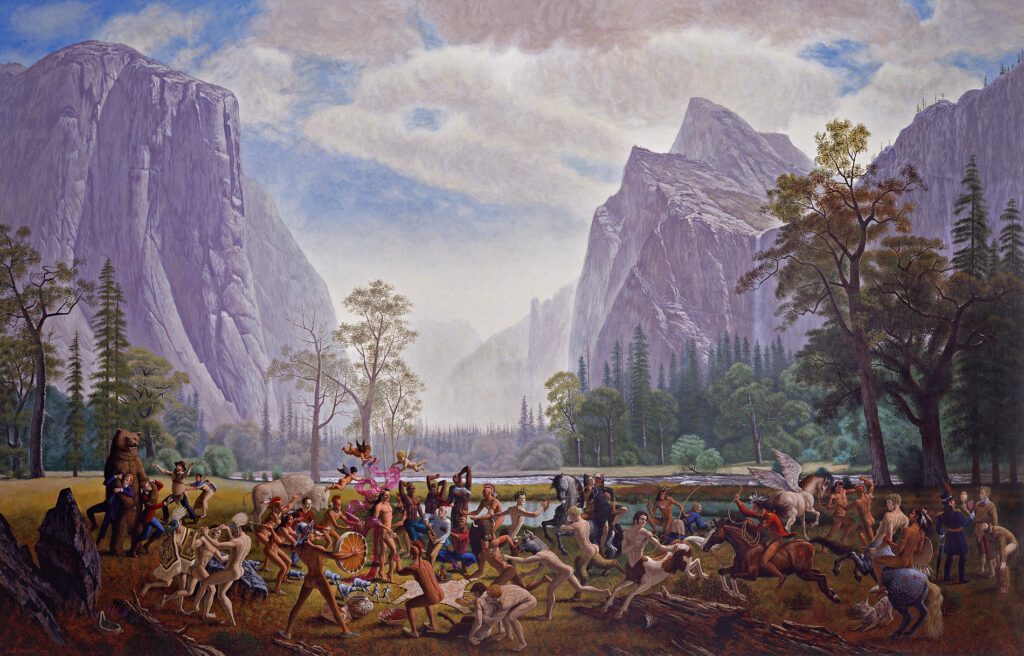
Kent Monkman is a provocative and at times controversial Cree artist who was born St. Mary’s, Ontario, in 1965. He grew up in Winnipeg with his three siblings, his father facing ostracization from the middle- to upper-class community they moved to so that Monkman and his siblings could have better education opportunities. Monkman showed an interest in art from a very young age, being one of the few children in his elementary school given the opportunity to attend free classes at the Winnipeg Art Gallery allowing having been life-changing to him.1 Monkman’s artwork explores sexuality, colonisation, resilience, and considers Indigenous experiences through an art style reminiscent of Renaissance art.2
Achilles and Patroclus

Created in 2008, Achilles and Patroclus is an oil painting that depicts a warm, light landscape with two lovers at the center, juxtaposed with the numerous bloody bodies of soldiers around them. The title of the piece refers to the figures of Achilles and Patroclus in Greek mythology, the two figures’ relationship as lovers being a major cause of the myth’s resurgence in popular media.3
The Scream

Deriving it’s title from the famous painting of the same name by Edvard Munch, The Scream is an acrylic painting made in 2017 and displayed at the Denver Art Museum. The piece depicts the RCMP and members of the Catholic clergy forcing Indigenous children away from their families, with Indigenous parents fighting back and children in the background on the run. The piece is ambigious in how it references both the Residential school system and the 60s Scoop, both being methods for the Canadian government to assimilate Indigenous peoples.4
The Triumph of Mischief

Held in the National Gallery of Canada in Ottawa, The Triumph of Mischief is a large piece that depicts numerous figures in a detailed landscape. Created in 2007, multiple notable figures in history, such as Picasso and William Clark, are painted alongside figures from Indigenous mythology and cultures. The figures in the painting are depicted as engaging in violence and sexual acts, depicting colonial figures in ways that are contrary to the dominant perceptions of colonisation.5
Personal Reflection
Similarly to why Dayna Danger’s work interests me, the major themes of sexuality in Monkman’s work is a part of what draws me to his paintings. The style of his paintings in itself feel like a reconsideration of Christian perspectives and culture, with Monkman referencing or reconstructing poses seen in famous Renaissance art in his works. Specifically, The Triumph of Mischief reminds me of The Garden of Earthly Delights by Bosch in terms of how they both depict scenes of people engaging in acts perceived as sinful by the Christian culture. But Monkman’s work differs in that, rather than portraying sexuality and especially homosexuality as sinful, it is more a celebration of Indigenous sexuality before colonisation.
- Madill, Shirley. “Kent Monkman: Life and Work.” Art Canada Institute. https://www.aci-iac.ca/art-books/kent-monkman/biography/#early-years ↩︎
- “Biography.” Kent Monkman. https://www.kentmonkman.com/biography ↩︎
- “Achilles and Patroclus.” Kent Monkman. https://www.kentmonkman.com/painting-2001-2019/2008/achilles-and-patroclus
↩︎ - Madill, Shirley. “The Scream 2017.” Art Canada Institute.https://www.aci-iac.ca/art-books/kent-monkman/key-works/the-scream/ ↩︎
- Madill, Shirley. “The Triumph of Mischief 2007.” Art Canada Institute. https://www.aci-iac.ca/art-books/kent-monkman/key-works/the-triumph-of-mischief/ ↩︎